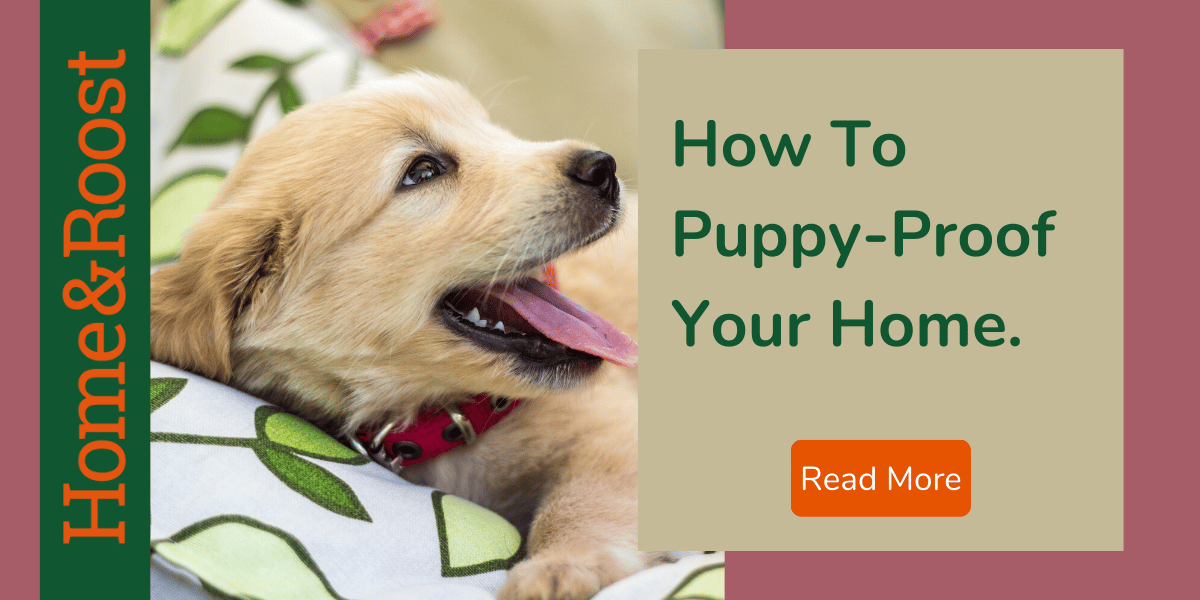There aren’t many things that are more exciting than bringing home a new puppy! Get ready for years of cuddles, companionship, and playtime. Obviously, you’re ready to add a new dog to the mix. But is your home equally prepared?
Puppy-proofing is a must for all dog owners, and it’s something you should address before bringing your dog home. Take some time to prepare your home and ensure that it’s a safe place for your dog to eat, sleep, and play.
To make the process a bit easier, we’ve put together a room-by-room guide to keep your pup safe and happy while they’re home.
Main Living Areas
- Secure or cover all electrical cords and wall outlets. Don’t let your dog get a shocking surprise! Use cord boxes and safety plugs to keep your pup from chewing or investigating something they shouldn’t.
- Rearrange the furniture if necessary. Puppies are curious and often end up in places where they shouldn’t be. Assess your furniture and make sure there are no places where your dog could get stuck. Similarly, make sure there are no tall shelves that could be knocked over.
- Get rid of any toxic plants. Did you know that some houseplants are toxic to dogs? Find out which plants are unsafe for animals and get rid of them if necessary.
- Store the cat litter box in an isolated location. If you have a cat, you’ll need to place the litter box somewhere your dog cannot reach. For many families, this can be done by blocking off a certain room with a baby gate.
- Secure all entry and exit points of your home. Look at all of your doors and windows to make sure they all close and lock properly. You should also make sure everyone in your household knows to firmly close doors behind them when coming and going. These measures should decrease your pup’s chance of escaping if they ever get too curious.
Source: https://pixabay.com/photos/room-dog-animal-sofa-puppy-hide-5205125/
The Kitchen
- Safely store all cleaning products. Any chemicals or cleaning products should be stored where your dog could never access them. If you keep them in a lower cabinet, you may even consider using child-safe locks to prevent a curious puppy from pushing the door open with his nose!
- Get a heavy-duty rubbish bin. The garbage is full of curious smells that your puppy can’t wait to investigate. Keep them from dragging it all about your house by using a rubbish bin that is tall and not easily knocked over. One with a lid is preferable.
- Clear the countertops. It might look like your countertops are high enough off the ground, but you’d be surprised how easily a large-breed puppy can knock things off onto the floor. Avoid the surprise by keeping your countertops clear.
- Keep all human food out of reach. Just like plants, some types of human food can be harmful to dogs. Even if not toxic, it’s best that your dog follows a veterinarian-recommended diet of dog food only. Keep all human food stored in the refrigerator or behind closed doors.
Source: https://pixabay.com/photos/kitchen-home-interior-modern-room-2165756/
The Bathroom
- Keep the toilet lid closed. As soon as your puppy grows tall enough to do so, you can bet they’ll be sticking their head in places it doesn’t belong! That toilet is going to look like one big and exciting water bowl. Squash your pup’s curiosity by keeping the lid closed.
- Secure all medication. If you have a wall-mounted medicine cabinet, that’s one of the best places to store your medications. If not, keep it in a cabinet or closet that your dog cannot get to.
Outdoors
- Put up a fence if possible. The best way to puppy-proof your garden is to close it in! If possible, install a fence so your pup can have free reign of the property. Make sure there are no gaps where a small puppy could squeeze through.
- Keep the lawn trimmed. Did you know that keeping your lawn manicured is another way to keep your pup safe? Fleas and ticks thrive in shady and moist environments, so cutting the grass regularly can help prevent infestations.
- Puppy proof your pond or pool. Just like the toilet bowl, many pups will want to investigate a pond or pool in your garden. Whilst it may be easy enough for a pup to get into pond or pool, it can be much more difficult for them to get out. So be sure your pup is supervised around pools and ponds in your garden, or fence those areas off.
Source: https://pixabay.com/photos/adorable-animal-canine-cute-dog-1849992/
Speaking of supervision, no amount of puppy-proofing can substitute for human supervision. Even in the safest environment, pet owners should spend lots of quality time with their dogs to ensure they stay safe and healthy. And if you notice something is wrong—if it appears that they’ve injured themselves or if they’re showing signs of illness, like the presentation of heartworm symptoms—you should get your pup to the vet right away.








